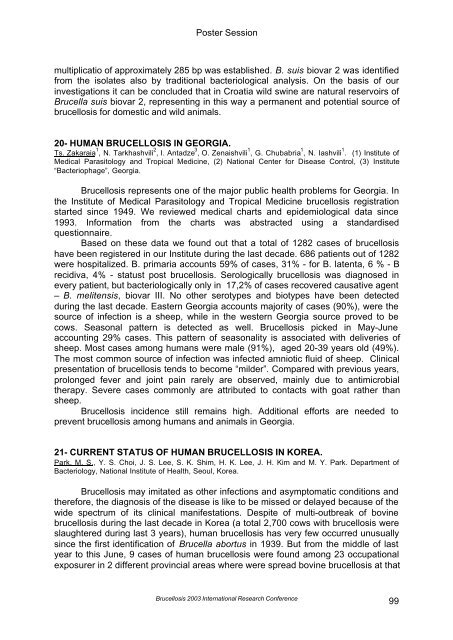Brucellosis 2003 proceedings - PHIDIAS
Brucellosis 2003 proceedings - PHIDIAS
Brucellosis 2003 proceedings - PHIDIAS
Create successful ePaper yourself
Turn your PDF publications into a flip-book with our unique Google optimized e-Paper software.
Poster Session<br />
multiplicatio of approximately 285 bp was established. B. suis biovar 2 was identified<br />
from the isolates also by traditional bacteriological analysis. On the basis of our<br />
investigations it can be concluded that in Croatia wild swine are natural reservoirs of<br />
Brucella suis biovar 2, representing in this way a permanent and potential source of<br />
brucellosis for domestic and wild animals.<br />
20- HUMAN BRUCELLOSIS IN GEORGIA.<br />
Ts. Zakaraia 1 , N. Tarkhashvili 2 , I. Antadze 3 , O. Zenaishvili 1 , G. Chubabria 1 , N. Iashvili 1 . (1) Institute of<br />
Medical Parasitology and Tropical Medicine, (2) National Center for Disease Control, (3) Institute<br />
“Bacteriophage”, Georgia.<br />
<strong>Brucellosis</strong> represents one of the major public health problems for Georgia. In<br />
the Institute of Medical Parasitology and Tropical Medicine brucellosis registration<br />
started since 1949. We reviewed medical charts and epidemiological data since<br />
1993. Information from the charts was abstracted using a standardised<br />
questionnaire.<br />
Based on these data we found out that a total of 1282 cases of brucellosis<br />
have been registered in our Institute during the last decade. 686 patients out of 1282<br />
were hospitalized. B. primaria accounts 59% of cases, 31% - for B. latenta, 6 % - B<br />
recidiva, 4% - statust post brucellosis. Serologically brucellosis was diagnosed in<br />
every patient, but bacteriologically only in 17,2% of cases recovered causative agent<br />
– B. melitensis, biovar III. No other serotypes and biotypes have been detected<br />
during the last decade. Eastern Georgia accounts majority of cases (90%), were the<br />
source of infection is a sheep, while in the western Georgia source proved to be<br />
cows. Seasonal pattern is detected as well. <strong>Brucellosis</strong> picked in May-June<br />
accounting 29% cases. This pattern of seasonality is associated with deliveries of<br />
sheep. Most cases among humans were male (91%), aged 20-39 years old (49%).<br />
The most common source of infection was infected amniotic fluid of sheep. Clinical<br />
presentation of brucellosis tends to become “milder”. Compared with previous years,<br />
prolonged fever and joint pain rarely are observed, mainly due to antimicrobial<br />
therapy. Severe cases commonly are attributed to contacts with goat rather than<br />
sheep.<br />
<strong>Brucellosis</strong> incidence still remains high. Additional efforts are needed to<br />
prevent brucellosis among humans and animals in Georgia.<br />
21- CURRENT STATUS OF HUMAN BRUCELLOSIS IN KOREA.<br />
Park, M. S., Y. S. Choi, J. S. Lee, S. K. Shim, H. K. Lee, J. H. Kim and M. Y. Park. Department of<br />
Bacteriology, National Institute of Health, Seoul, Korea.<br />
<strong>Brucellosis</strong> may imitated as other infections and asymptomatic conditions and<br />
therefore, the diagnosis of the disease is like to be missed or delayed because of the<br />
wide spectrum of its clinical manifestations. Despite of multi-outbreak of bovine<br />
brucellosis during the last decade in Korea (a total 2,700 cows with brucellosis were<br />
slaughtered during last 3 years), human brucellosis has very few occurred unusually<br />
since the first identification of Brucella abortus in 1939. But from the middle of last<br />
year to this June, 9 cases of human brucellosis were found among 23 occupational<br />
exposurer in 2 different provincial areas where were spread bovine brucellosis at that<br />
<strong>Brucellosis</strong> <strong>2003</strong> International Research Conference<br />
99
















